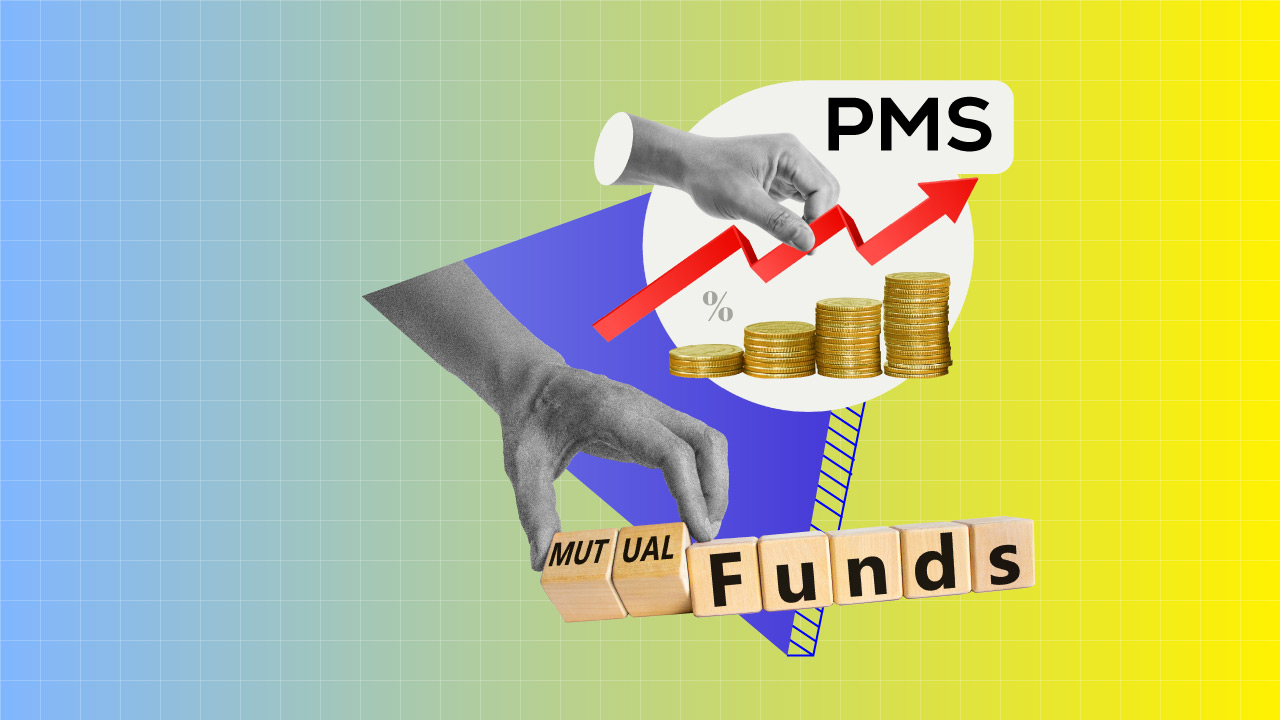SIP Calculator
×PMS vs. mutual fund: Understanding the differences

We have all heard a lot about wealth creation through investing, the benefits of compounding, and how investing is the best way to make your money work for you. Finance gurus, investment advisors, and influencers all agree that investment is the key to growing your wealth.
We all know investing is important, so the next question is, where do you invest? Do you choose multiple mutual funds and manage your investments yourself or do you choose a Portfolio Management Service (PMS) for professional management of your investments? Read on to learn more about PMS vs mutual funds and which one to choose to achieve your investment goals.
What is PMS and how does it work?
Portfolio Management Services (PMS) is a professional financial service where qualified portfolio managers manage your investment portfolio with the help of a research team. The investments are made in a mix of assets such as equities, fixed income, commodities, structured products, cash and cash equivalents, etc.
PMS will analyze the needs and the investment goals of the client before making portfolio allocations. PMS investment allocations will vary from one account to another as they are tailored to match an individual’s investment objectives, risk appetite, and time frames.
Fees/charges of PMS
The PMS fee structure is not fixed. Different PMS options will have different fee structures that can be determined at the time of enrollment. Some of the common charges associated with PMS are mentioned below:
- Entry Load
PMS usually charges an entry load between 1% to 3%. This is a one-time cost that is payable by investors who opt for the scheme.
- Operating Expenses
These are recurring charges levied for managing the portfolio and are capped at 0.5% of the average daily asset under management per year by market regulator SEBI.
- Brokerage Charges
PMS providers levy brokerage charges for each market transaction.
- Exit Load
Exit load is levied to discourage early withdrawal. PMS may charge up to 3% for withdrawals in the first year. The second and third-year charges are 2% and 1%, respectively. No charges apply after the third year.
“Start investing with confidence! Explore the best mutual funds and grow your wealth.”
Differences between PMS and mutual fund
Portfolio management services and mutual funds are different ways to create wealth. However, the approach followed has some similarities and differences. While similarities such as professional fund management are often discussed, few focus on the differences between the two. It is important to know the differences between PMS and mutual funds before making an investment decision.
- Risk involved
PMS is a high-risk, high-reward investment game. While mutual funds also have some degree of risk involved depending on the type, the risk involved in PMS is greater than that of mutual funds.
- The minimum investment requirement
The minimum investment requirement for PMS as mandated by SEBI is Rs. 50 lakhs. The high minimum threshold ensures that only those who can tolerate PMS-related risks enter the fray. This makes investing via PMS an entirely different league compared to mutual funds where the minimum investment requirement for some schemes is as low as Rs. 100.
- Account types
PMS providers must maintain different demat accounts for each investor whereas mutual funds will pool investor money and invest the pooled funds. While a PMS solution is tailor-made to suit a client’s need, mutual fund schemes have no room for customization. Investors will have to choose the best-suited MF scheme from available options.
- Transparency
PMS offers a lot more transparency than mutual fund investments. This is because PMS transactions happen in a demat account and the data for each executed trade can be tracked through demat account transactions. This is not the case with mutual funds.
- Regulations
Mutual funds have a strict operational framework and are closely regulated by SEBI. This is not the case with PMS as it is a private agreement between the PMS provider and the client.
- Charges
PMS provides personalized investment services and hence their charges tend to be higher than mutual funds. Moreover, PMS can also have profit-sharing fees on crossing a predecided hurdle rate. The charges as well as the profit sharing will be mentioned in the agreement when the client selects the PMS provider.
Types of mutual funds and PMS
Mutual fund types
Mutual fund schemes are categorized based on asset type and structure. The broad asset classification is equity, debt, and hybrid funds. Based on the structure, they are classified as open-ended, close-ended, and interval funds.
An index fund is a popular type of mutual fund where the fund mimics the index it is tracking to replicate the risk-return profile of the index. Nifty50 index fund is an example of an index fund.
PMS types
Portfolio management services are classified based on the management style. These are discretionary and non-discretionary services. The discretionary-managed PMS is managed at the discretion of the portfolio manager, with the manager making buy and sell decisions. Under the non-discretionary fund management service, the portfolio manager makes suggestions and the investor has to make the investment decision.
Most portfolio management services in India are discretionary providers.
Factors to consider before investing in PMS
Here are the factors that should be considered before investing in a PMS.
- Risk tolerance
PMS courts a higher risk compared to mutual funds. Investors should assess their risk appetite before putting their money in a PMS.
- Past performance
While past performance is not indicative of future returns, past performance should be analyzed to get a fair idea about the management style and returns before investing.
- Major expenses
PMS expenses involve accounting, custody, brokerage charges, exit loads, performance-based profit-sharing charges, and management fees.
- Investment objectives
Before investing, the client should understand the PMS provider’s investment strategy and make sure that it aligns with his investment objectives.
- Portfolio manager’s experience
The fund manager’s experience should be considered. In fact, the manager’s investment ideology will impact your portfolio performance.
Factors to consider before investing in mutual funds
Investors should consider the following factors before investing in mutual funds:
- Risk appetite
Mutual fund schemes are classified into 5 risk levels. These are low, moderately low, moderate, moderately high, and high. Investors should choose schemes that match their risk profile.
- Expense ratio
Mutual fund houses have operating costs. The expense ratio represents the fees charged by the asset management company for operating a mutual fund scheme. The expense ratio eats up the investment returns and thus funds with a low expense ratio should be chosen.
- Historical performance
While historical performance doesn’t guarantee future returns, checking historical performance can give you an idea about the investment style, volatility, performance, and more.
- Assets under management (AUM)
AUM is the total market value of a particular mutual fund.
Should you invest in PMS as well as mutual funds?
Portfolio Management Services and mutual funds are both wealth-creation tools with different risk profiles. While they offer different risk profiles and have different minimum investment requirements, investors often get confused and think of investing through both. As an investor, should you DIY your investments through mutual funds and also avail PMS services? Can this help your overall returns?
The simple answer is, no. Channeling your investments through mutual funds and availing PMS at the same time can hinder your wealth creation journey by increasing complexity in your investments. It can also prove to be expensive due to higher transaction costs and also lead to over-diversification.
Therefore, if you are looking to invest upwards of Rs. 50 lakhs and want to avail the services of a professional, you can opt for a PMS. But if you do not have the necessary initial investment amount or are comfortable managing and monitoring your investments yourself, you can opt for SIPs or lumpsum investments in mutual funds.
Conclusion
PMS vs. mutual funds is a long-standing debate, but the choice between the two depends on your risk tolerance, your investment corpus, and investment goals. Investors with a minimum corpus of Rs. 50 lakhs looking for professional management of their investments can opt for a PMS service. On the other hand, those with a smaller corpus or those comfortable with managing their portfolios themselves can choose mutual fund investments.




